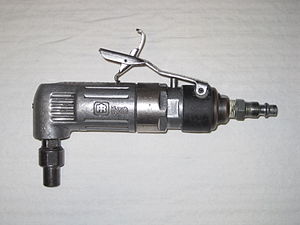Rotary tool
This articleis written like apersonal reflection, personal essay, or argumentative essaythat states a Wikipedia editor's personal feelings or presents an original argument about a topic.(February 2020) |


Adie grinderorrotary toolis a handheldpower toolandmultitoolused forgrinding,sanding,honing,polishing,ormachiningmaterial (typically metal, but also plastic or wood). All such tools are conceptually similar, with no bright dividing line between die grinders and rotary tools, although thedie grindername tends to be used forpneumaticallydriven heavy-duty versions whereas therotary toolname tends to be used for electric lighter-duty versions.Flexible shaftdrive versions also exist.
Thedie grindername comes from one of their earliest and archetypal applications,tool and die work,where they were used to create the precise contours ofdiesormolds.Especially before the advent of widespreadCNCusage, they were heavily relied upon for contouring via manual skill comparable to asculptor's.CNC now provides much of the contouring for die and mold interior surfaces, but die grinders are still very useful for hundreds of cutting needs, from sculpture-like contouring in the absence of CNC, to cut-off ofbar stock,to any of the cutting and grinding needs offabrication,such as in the work of welders, boilermakers, millwrights, ironworkers (steel erectors), sheet metal workers (such asauto body workersandHVACtechnicians), towoodworking(especiallycabinet making),hacking,and other hobby or business pursuits. Die grinders are often used forengraving,cylinder head porting,and general shaping of a part.[1]
Die grinders typically rotate at a high speed, typically 25,000 rpm. This is much faster than most cutting tools. As such, one must use accessories rated for such a high rpm to avoid the tool shattering.
Methods of cutting action
[edit]The cutting may be done in various ways, including:
- Grinding withbonded abrasivestones (called by various names, such as mounted stones, mounted points, or grinding points)
- Machining with aburror smalldrill bitorendmill
- Sanding withcoated abrasive,such as small drums made of sandpaper mounted on an expanding rubbermandrel(also called an arbor)
- Honingwith fine-grit mounted points
- Lappingwith lapping compound and a mounted lap to embed it
- Polishing or buffingwith cloth or fiber drums or flaps and polishing compound
Types of cutters
[edit]- Mounted stones of many shapes and various [small or medium] sizes (also called mounted points or grinding points)
- Burrsof many shapes and various [small or medium] sizes (also called rotary files)
- Smalldrill bits
- Smallendmills
- Small disc-shapedsawblades ormilling cutters
- Small abrasive cut-off wheels, which work like saw blades except via abrasive cutting rather than sawing per se
- Small sanding drums
- Small sanding flap wheels
- Small cloth or fiber wheels, drums, and flap wheels (for holding polishing compound)
- Mounted laps
Methods of holding the cutter
[edit]The cutter is usually held in acollet,which is a convenient means ofchuckingin this application and provides the concentricity needed for high-RPM use. It also allows for quick changes in cutters.[1][2]In some applications, other quick-changeindexablechucking systems can be used, similar to the indexable chucking types now commonly found on consumer pistol-gripdrills.
Safety
[edit]Personal protective equipment (PPE)
[edit]The most universal safety precaution in die grinder use is to protect one's eyes bywearingsafety glasses.
Other commonPPEin die grinder use includes:
- Other eye and face protection,such assafety gogglesor a face shield, which is simply a polycarbonate window, hanging from a headband, between one's face and the work. All eye protectors come in clear versions as well as various levels of shading (for grinding that produces enough sparks to warrant shading, like torching or welding do).
- Hearing protection,such asear plugsorheadphones(die grinders are often quite loud, even just running unloaded, but even more so while cutting).
- Skin protection,such as work gloves (and in some special applications, fire-retardant clothing because of the sparks, although the sparks are usually harmless in most applications).
- Protection for the respiratory and alimentary tracts(mouth, throat, lungs, gut), such as simplepaper masksor, in special applications, arespirator.Masks may be trivial in many applications but important in others. Any abrasive cutting generates dust, from both the abrasive itself and from the workpiece. Depending on the materials and amounts, masks may be needed.
Safety features built into the tool
[edit]Most pneumatic die grinder throttles (also called triggers) feature a spring-loaded "kickstand" mechanism between the throttle lever and the body of the grinder. This prevents the throttle from opening (being pressed down towards the body of the grinder) without operator intervention and inhibits accidental activation. It is similar in principle to thesafety catchesused on manyhandguns.
Tools with electric motors often have electrical safety features such as grounded cases (wired to a grounding conductor, which uses the grounding prong on a plug) ordouble insulation.Some may have both, but this is uncommon, becauseregulatory requirementsrequire only one or the other.
See also
[edit]References
[edit]- ^abBenford, Tom (2006),Garage and Workshop Gear Guide,MotorBooks/MBI Publishing, p. 87,ISBN978-0-7603-2312-0.
- ^Monroe, Tom (1996),Engine builder's handbook,HPBooks, p. 27,ISBN978-1-55788-245-5.
